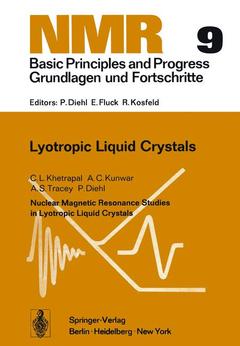Nuclear Magnetic Resonance Studies in Lyotropic Liquid Crystals, Softcover reprint of the original 1st ed. 1975 Nuclear Magnetic Resonance Studies in Lyotropic Liquid Crystals NMR Basic Principles and Progress Series, Vol. 9
Langue : Anglais
Auteurs : Khetrapal CL, Kunwar A., Tracey A.S., Diehl P.

1. Lyotropic Liquid Crystals The class of compounds known as thermotropic liquid crystals has been widely utilized in basic research and industry during recent years. The properties of these materials are such that on heating from the solid to the isotropic liquid state, phase transitions occur with the formation of one or more intermediate anisotropic liquids. The unique and sometimes startling properties of these liquid crystals are the properties of pure compounds. However, there exists a second class of substances known as lyotropic liquid crystals which obtain their anisotropic properties from the mixing of two or more components. One of the components is amphiphilic, containing a polar head group (generally ionic or zwitterionic) attached to one or more long-chain hydrocarbons; the second component is usually water. Lyotropic liquid crystals occur abundantly in nature, particularly in all living systems. As a consequence, a bright future seems assured for studies on such systems. Even now, many of the properties of these systems are poorly understood. It is the purpose of this review to consolidate the results obtained from nuclear magnetic resonance studies of such systems and to provide a coherent picture of the field. Probably the most familiar example of a lyotropic liquid crystal is soap in water. A common soap is sodium dodecylsulphate where an ionic group (sulphate) is attached to a hydrocarbon chain containing twelve carbons.
I. Introduction.- 1. Lyotropic Liquid Crystals.- 2. Basic Principles.- 2.1. Spectra of Lyotropic Phases.- 2.1.1. Nuclei with Spin I = 1/2.- 2.1.2. Nuclei with Spin I > 1/2.- 2.2. Spectra of Molecules Dissolved in Nematic Lyotropic Phases.- 2.2.1. The Hamiltonian.- 2.2.2. Direct Coupling and Degree of Order.- 2.2.3. Interpretation of the Dipolar Couplings and Obtainable Structural Information.- 2.2.4. Chemical-shift Anisotropy.- 2.2.5. Anisotropic Contribution of the Indirect Spin-spin Couplings.- 2.2.6. The Quadrupole Interaction.- 3. Experimental.- 3.1. Preparation of Samples.- 3.2. NMR Measurements.- 3.2.1. Phases without Additional Solutes.- 3.2.2. Solutes Dissolved in Nematic Phases.- II. Studies of Lyotropic Liquid Crystals.- 4. Introduction.- 5. Applications.- 5.1. Critical Micelle Concentration.- 5.1.1. Chemical-shift Measurements.- 5.1.2. Spin-lattice Relaxation Time Measurements.- 5.2. Spectral Changes and Phase Transitions.- 5.3. Proton and Deuteron Magnetic Resonance in Hydrated Fibrous Materials.- 5.4. Self-diffusion in Lyotropic Liquid Crystals.- 5.5. Interactions of Ions in Anisotropic Media.- 5.5.1. Ordering of Spherical and Tetrahedral Ions.- 5.5.2. Ion Binding and Ion Competition.- 5.5.3. Halide Ions.- 5.5.4. Alkali Ions.- 5.5.5. Proton, Deuteron and Alkali Resonance Studies.- 5.5.6. PMR of Nonionic Surfactants in the Presence of Anionic Surfactants.- 5.5.7. 14N Quadrupole Interactions.- 5.6. Alkyl Chain Motion in Lyotropic Liquid Crystals.- 5.6.1. The Concept of the Order Parameter as Applied to the Hydrocarbon Chain.- 5.6.2. Structure and Dynamics of the Hydrocarbon Region.- 5.6.2.1. Micellar Solutions.- 5.6.2.2. Anisotropic Phases.- 5.7. Sonicated Lamellar Systems.- Appendix to Part II: Systems Reported.- III. Studies of Molecular and Ionic Species Dissolved in the Nematic Phase of Lyotropic Liquid Crystals.- 6. Introduction.- 7. Applications.- 8. Order in Nematic Lyotropic Phases.- 8.1. Some General Comments Concerning the Order Parameter.- 8.2. Molecular and Ionic Species in Aqueous Phases.- 8.2.1. Benzenes and Related Compounds.- 8.2.2. Ionic Species as Solutes.- Appendix to Part III. Compounds Studied and Information Derived.- Acknowledgements.- References.
Date de parution : 10-1975
Date de parution : 03-2012
Ouvrage de 88 p.
17x24.4 cm
Disponible chez l'éditeur (délai d'approvisionnement : 15 jours).
Prix indicatif 105,49 €
Ajouter au panierThème de Nuclear Magnetic Resonance Studies in Lyotropic Liquid... :
© 2024 LAVOISIER S.A.S.
